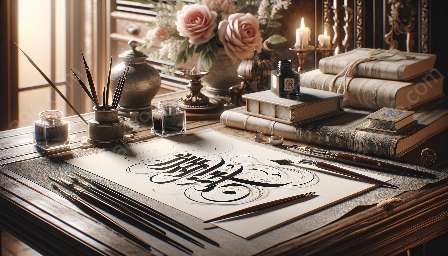Calligraphy is an ancient art form that requires an assortment of specialized tools and materials to create beautiful and expressive lettering. Whether you are a beginner or a seasoned calligrapher, understanding the fundamental elements of calligraphy is essential for mastering this intricate craft.
1. Nibs
Nibs are one of the most important tools in calligraphy. They come in various shapes and sizes, each providing a different line width and stroke texture. Calligraphy nibs are typically made of metal and are designed to hold and dispense ink smoothly onto the writing surface.
2. Ink
High-quality ink is essential for achieving optimal results in calligraphy. Calligraphy inks are available in a wide range of colors and consistencies, including traditional black ink, vibrant colored inks, and specialized metallic and shimmering options. Choosing the right ink for your project can significantly impact the final outcome of your calligraphic work.
3. Paper
The selection of paper is crucial in calligraphy, as it affects the appearance and durability of the lettering. Smooth and absorbent papers are preferred for calligraphy, allowing the ink to flow smoothly without feathering or bleeding. Calligraphers often experiment with different types of paper to find the best match for their preferred writing style and ink choice.
4. Brushes
Brushes are commonly used in brush calligraphy, also known as brush lettering or brush script. The type and quality of the brush can significantly impact the fluidity and expression of the calligraphic strokes. Calligraphy brushes are available in various sizes and shapes, catering to different writing styles and techniques.
5. Pen Holders
Pen holders, also known as nib holders, are essential for securely attaching and controlling the nib during the calligraphy process. They come in different materials, including wood, plastic, and metal, and can be customized to accommodate various nib sizes and styles.
6. Rulers and Guidelines
Rulers and guidelines are indispensable tools for maintaining consistency and precision in calligraphy. Guidelines help calligraphers align and space their letters accurately, while rulers assist in creating straight lines and maintaining uniform letter heights.
7. Erasers and Correcting Fluid
Mistakes happen, even in calligraphy. Erasers and correcting fluid are essential for rectifying errors and refining the overall appearance of the calligraphic work. These tools allow calligraphers to correct minor imperfections without compromising the integrity of the lettering.
8. Practice Sheets
Practice sheets provide calligraphers with a structured platform to refine their skills and experiment with different styles and techniques. These sheets often feature pre-printed guidelines and lettering examples, allowing aspiring calligraphers to practice and improve their craft.
9. Workspace and Lighting
Creating a conducive workspace with adequate lighting is crucial for calligraphers. Proper illumination and a comfortable working environment can significantly enhance the precision and quality of the calligraphic writing.
By understanding and utilizing these fundamental tools and materials, aspiring calligraphers can embark on a captivating journey of self-expression and artistic exploration. Whether practicing traditional scripts or experimenting with modern calligraphic styles, the right tools and materials play a fundamental role in shaping the art of calligraphy.

